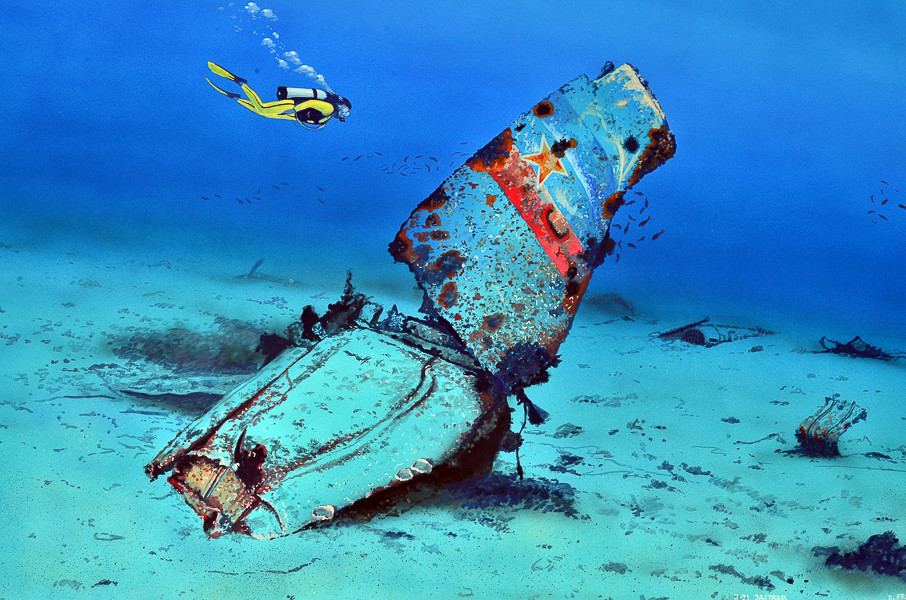
SOKO J-21 JASTREB
DEPTH: 9 - 10 m
SKILL: Beginner
Soko J-21 Jastreb; attack aeroplane; Yugoslav Air Force
Crashed: 18th or 19th September 1991 (anti-aircraft defence)
Dimensions: l=10.88 m, wingspan=10.56 m (11.68 with additional tanks)
Coordinates: 43.51167° N, 15.95667° E
Location: Rogoznica, cove of Movar
Access: 4/5 access is possible by boat or from the land
Visibility: 3-4/5 good, and sometimes very good
Current: 3/5 weak, only occasionally moderate
Flora and fauna: 2/5 uniform life on and around the wreck
HISTORY:
The Soko J-21 Jastreb is a single-seat, attack-reconnaissance jet aeroplane which was designed and manufactured in Yugoslavia in the 1960’s. It looks similar to the G-2 Galeb on the basis of it was also developed. At the time when it was designed, the Jastreb was mostly used as a jet for the training of pilots and reconnaissance, although it could be used for ground attacks on targets as it was designed primarily as an attack aircraft.
During the first months of the war way back 1991, the Yugoslav Air Force widely used the attack J-21 Jastreb in attacks on Croatian military formations. This was during the time of furious battles in the seizing of barracks by Croatian forces, the then officially titled Croatian National Guard (ZNG) with the simultaneous withdrawal of the JNA (Yugoslav National Army) formations from the coastal parts of Croatia. Tanks of the JNA from positions close to the Šibenik bridge, opened fire on the city and its outskirts. Aircraft bombed Šibenik and Vodice many times. Croatian forces vigorously defended themselves, the fighting lasted all day, and according to unverified information three aeroplanes and one helicopter of the JNA forces were destroyed. The JNA barracks were completely surrounded.
Members of the Croatian National Guard and Ministry of the Interior (MUP) took over the Velimir Škorpik overhaul and the Kuline barracks at Šibenik. Croatian forces came upon one missile carrying gunboat, two obsolete missile boats, and also captured one motor torpedo boat, three patrol boats, eight landing assault craft and five landing minelayers.
All the aircraft were destroyed with light anti-aircraft guns or Strela and Igla types of portable rocket launchers. One of them, the attack jet type J-21 Jastreb of the 97th Air Brigade 240th Light Bomber Squadron which was flown by 27 year old pilot Valter Juršić was shot down over the sea in the cove of Movar not far from Rogoznica. The pilot did not escape.
WRECK CONDITION AND DIVING:
The remains of the aeroplane are scattered over a wide circle on a sandy bottom at a depth of about 10 metres. With good visibility parts of the aeroplane can be easily made out even from the surface. By the condition of the remains it can be concluded that the aeroplane hit the surface at high speed because the force of the crash completely destroyed it and pieces of it were dispersed in a hundred metre circle radius. On the seabed can be found shattered and deformed parts of the fuselage and engine, crumpled panelling and twisted parts of the main wing and various electrical circuits.
Particular attention is drawn to the tail of the aeroplane, where on the vertical fin can still be seen the Yugoslav tricolour with its red star. Unfortunately, the serial number which would be the key to accurately confirm the identity of the aeroplane which would have been written in black below the tricolour is barely discernible and can no longer be read with certainty.
The best preserved parts are the main undercarriage legs and the under-wing rocket launchers. The wheels and tyres of the undercarriage legs are missing, as they fell away with the force of the impact, but the shock-absorbers are still in good condition.
Close by the wings, partially buried in the sand, are the launchers for the unguided air-to-ground rockets. They were hung under the wings on special carriers, whilst the firing of the rockets was performed by electrical means, after the pilot had precisely aimed the aeroplane towards the target. Their four tubes for rockets are empty, which is a sign that the pilot had fired them before he was hit.
The J-21 Jastreb is one of a small number of underwater monuments to the Homeland War which started in 1991 and lasted for five complete years, the bloody wounds of which Croatia will long remember.
The description and illustrations are a courtesy of Danijel Frka and Jasen Mesić. Buy the whole book here: https://shop.naklada-val.hr/product_info.php?products_id=561
Crashed: 18th or 19th September 1991 (anti-aircraft defence)
Dimensions: l=10.88 m, wingspan=10.56 m (11.68 with additional tanks)
Coordinates: 43.51167° N, 15.95667° E
Location: Rogoznica, cove of Movar
Access: 4/5 access is possible by boat or from the land
Visibility: 3-4/5 good, and sometimes very good
Current: 3/5 weak, only occasionally moderate
Flora and fauna: 2/5 uniform life on and around the wreck
HISTORY:
The Soko J-21 Jastreb is a single-seat, attack-reconnaissance jet aeroplane which was designed and manufactured in Yugoslavia in the 1960’s. It looks similar to the G-2 Galeb on the basis of it was also developed. At the time when it was designed, the Jastreb was mostly used as a jet for the training of pilots and reconnaissance, although it could be used for ground attacks on targets as it was designed primarily as an attack aircraft.
During the first months of the war way back 1991, the Yugoslav Air Force widely used the attack J-21 Jastreb in attacks on Croatian military formations. This was during the time of furious battles in the seizing of barracks by Croatian forces, the then officially titled Croatian National Guard (ZNG) with the simultaneous withdrawal of the JNA (Yugoslav National Army) formations from the coastal parts of Croatia. Tanks of the JNA from positions close to the Šibenik bridge, opened fire on the city and its outskirts. Aircraft bombed Šibenik and Vodice many times. Croatian forces vigorously defended themselves, the fighting lasted all day, and according to unverified information three aeroplanes and one helicopter of the JNA forces were destroyed. The JNA barracks were completely surrounded.
Members of the Croatian National Guard and Ministry of the Interior (MUP) took over the Velimir Škorpik overhaul and the Kuline barracks at Šibenik. Croatian forces came upon one missile carrying gunboat, two obsolete missile boats, and also captured one motor torpedo boat, three patrol boats, eight landing assault craft and five landing minelayers.
All the aircraft were destroyed with light anti-aircraft guns or Strela and Igla types of portable rocket launchers. One of them, the attack jet type J-21 Jastreb of the 97th Air Brigade 240th Light Bomber Squadron which was flown by 27 year old pilot Valter Juršić was shot down over the sea in the cove of Movar not far from Rogoznica. The pilot did not escape.
WRECK CONDITION AND DIVING:
The remains of the aeroplane are scattered over a wide circle on a sandy bottom at a depth of about 10 metres. With good visibility parts of the aeroplane can be easily made out even from the surface. By the condition of the remains it can be concluded that the aeroplane hit the surface at high speed because the force of the crash completely destroyed it and pieces of it were dispersed in a hundred metre circle radius. On the seabed can be found shattered and deformed parts of the fuselage and engine, crumpled panelling and twisted parts of the main wing and various electrical circuits.
Particular attention is drawn to the tail of the aeroplane, where on the vertical fin can still be seen the Yugoslav tricolour with its red star. Unfortunately, the serial number which would be the key to accurately confirm the identity of the aeroplane which would have been written in black below the tricolour is barely discernible and can no longer be read with certainty.
The best preserved parts are the main undercarriage legs and the under-wing rocket launchers. The wheels and tyres of the undercarriage legs are missing, as they fell away with the force of the impact, but the shock-absorbers are still in good condition.
Close by the wings, partially buried in the sand, are the launchers for the unguided air-to-ground rockets. They were hung under the wings on special carriers, whilst the firing of the rockets was performed by electrical means, after the pilot had precisely aimed the aeroplane towards the target. Their four tubes for rockets are empty, which is a sign that the pilot had fired them before he was hit.
The J-21 Jastreb is one of a small number of underwater monuments to the Homeland War which started in 1991 and lasted for five complete years, the bloody wounds of which Croatia will long remember.
The description and illustrations are a courtesy of Danijel Frka and Jasen Mesić. Buy the whole book here: https://shop.naklada-val.hr/product_info.php?products_id=561

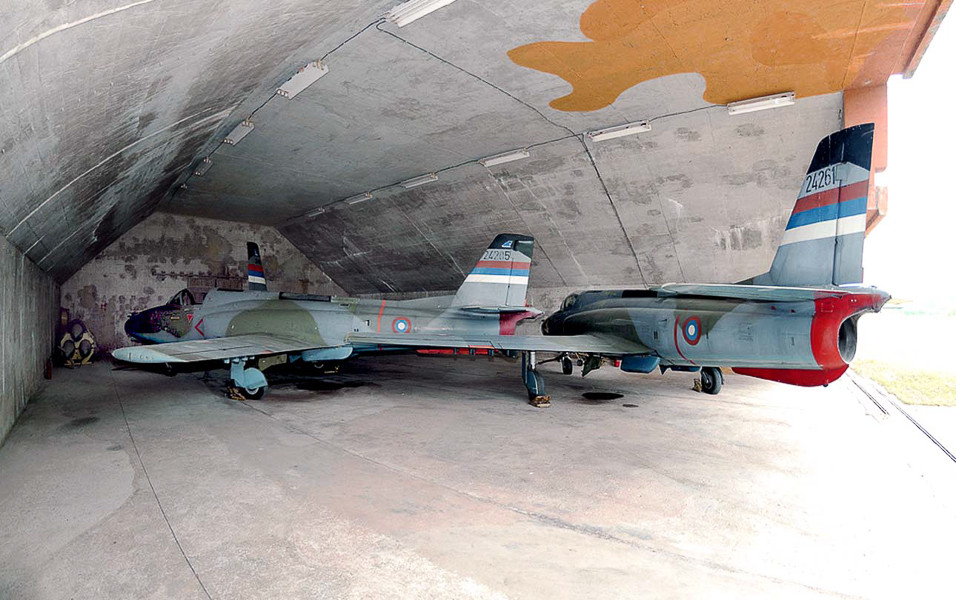
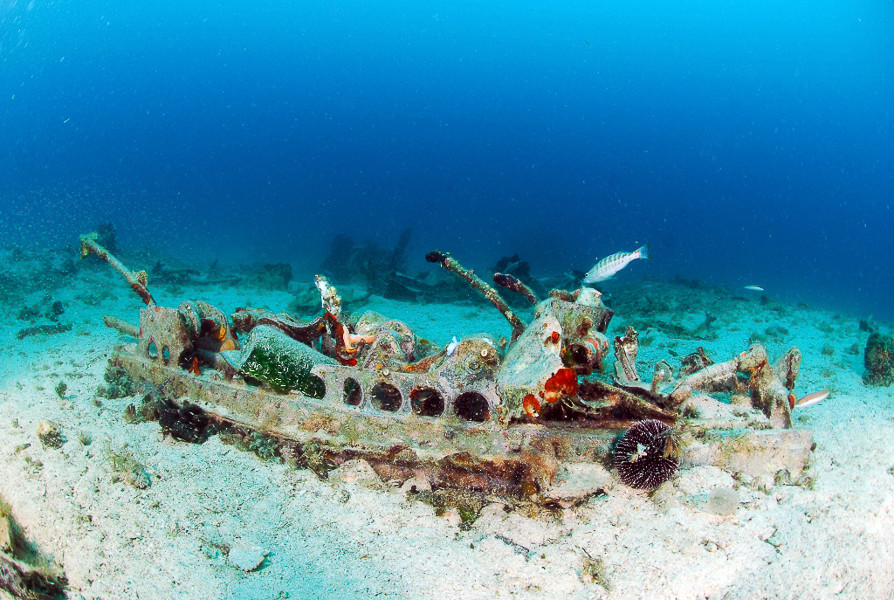
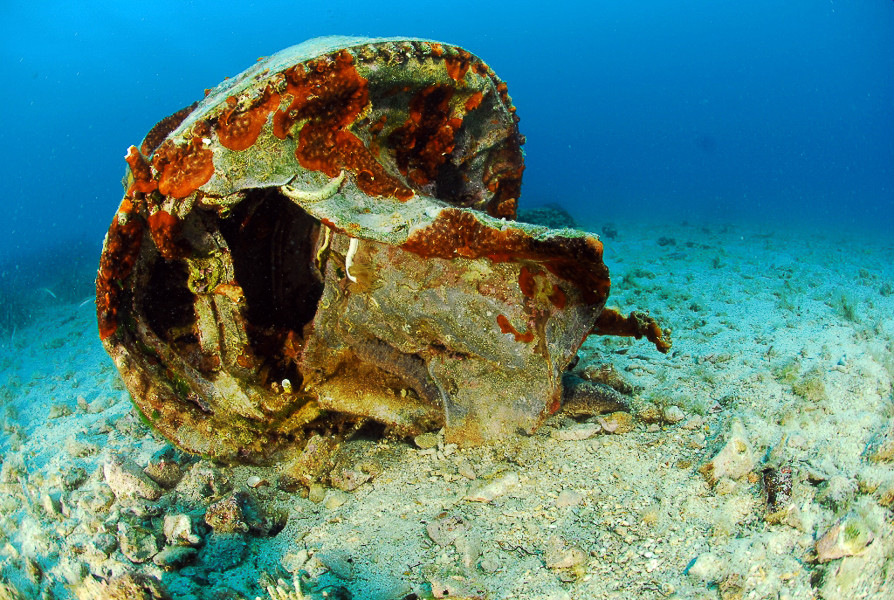
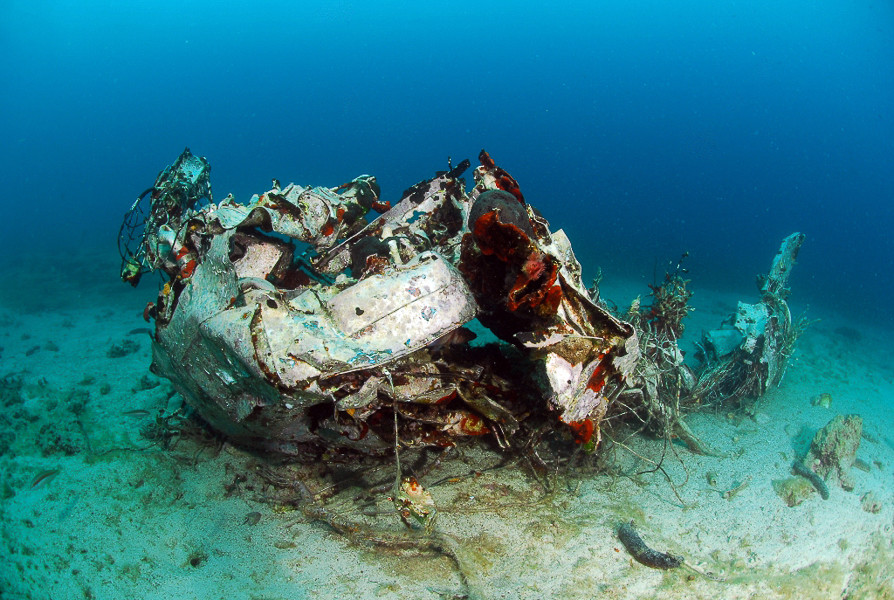


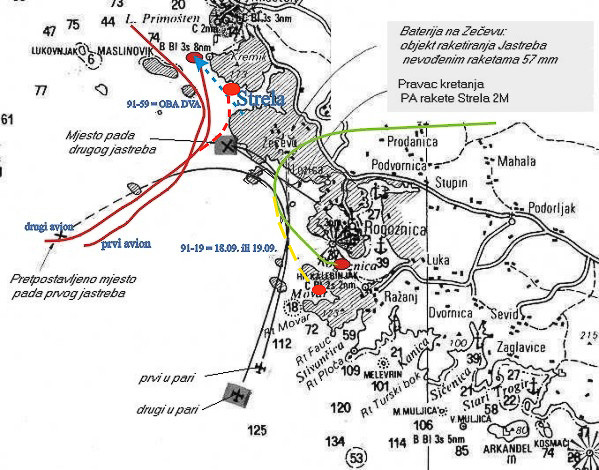
 The investment is co-financed by the Republic of Slovenia and the European Union from the European Regional Development Fund.
The investment is co-financed by the Republic of Slovenia and the European Union from the European Regional Development Fund.  H2O Globe BETA
H2O Globe BETA